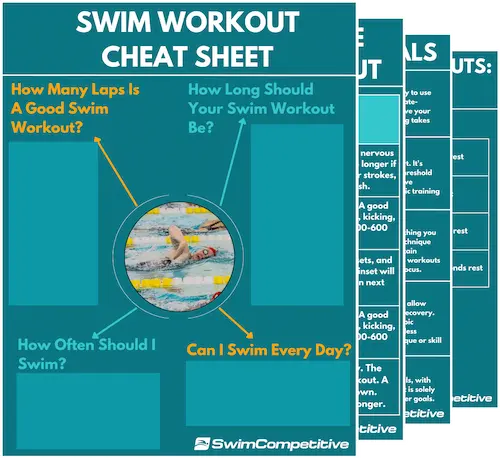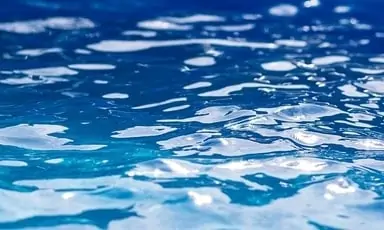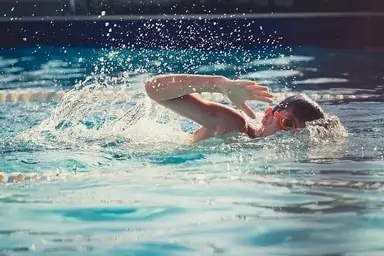Swimming is well known for its many advantages such as being a great all-around workout, burning a ton of calories, being low impact, strengthening your heart and cardiovascular system, and many more.
Something less discussed, however, are the disadvantages of swimming- and while there aren’t many- and all of the advantages greatly outweigh the disadvantages there are still a few, and that is what we’ll be looking at in today’s article.
The point of this article isn’t to downplay swimming in any way, but rather to make you aware of some of the things that aren’t exactly optimal so that you know to be prepared for them and how to deal with them if it comes to it.
5 Disadvantages of Swimming
1. The Disadvantage of Common Swimming Injuries
While swimming is generally one of the most low-impact sports out there, certain injuries are common among competitive swimmers. Your average swimmer shouldn’t have to worry too much about these injuries as they really only start occurring with excessive training and are commonly referred to as “overuse injuries”.
Here are some of the most common injuries among swimmers-
Swimmer’s Shoulder: Injury to the shoulder is by far the most common injury among swimmers. One study published in the Clinical Journal Of Sports Medicine found that 47% of collegiate swimmers and 48% of masters swimmers have experienced shoulder pain that lasted more than 3 weeks.
Another study published in the British Journal of Sports Medicine found that out of 80 elite swimmers between the ages of 13-25, 91% of them were experiencing shoulder pain at the time of the study. Upon further investigation, they were given an MRI, and it was found that 69% of these swimmers showed inflammation of the shoulder tendon.
A large contributor to swimmer’s shoulder is the overuse of the shoulder muscles, namely the rotator cuffs as the arms are rotating around thousands of times each workout. Another common factor contributing to shoulder injuries in swimming is improper or bad technique as this places an unnecessary strain on these muscles and tendons.
Swimmer’s Knee: Knee injuries are also one of the most common injuries among swimmers, with another study by the Clinics In Sports Medicine finding it to be the second most common injury reported among competitive swimmers.
This injury is most common among breaststroke swimmers where the knees play an important role in the kicking motion of the stroke. Similar to the shoulder injury, this injury is caused by overuse of the knee joints and ligaments as well as the use of improper or incorrect swimming technique.
Overuse injuries can be avoided by utilizing exercises specific to the strengthening of certain ligaments and muscles, such as the rotator cuffs for example. It is also advised to make sure to use good swimming technique at all times and to avoid swimming if you are experiencing pain.
If you are worried about losing fitness and you still want to hit the pool if you are experiencing some pain you can for example only do say kicking or pulling depending on where the pain is located.
Example- If you have shoulder pain then rather do a kick set that day and on the contrary, if you have knee pain do a pulling set on that day. Continue this until the pain has subsided and you are comfortable carrying on where you left off.
Other common conditions swimmers may experience are muscle cramps and muscle tightness. While these aren’t classified as injuries they can still create pain and discomfort for the swimmer. Muscle cramps are something more common among all levels of swimmers when executing similar movements repeatedly such as doing a kick set with fins (calf cramps).
Tightness is also something you’ll most likely experience after a hard workout. It should be noted that while muscle tightness isn’t comfortable it is in most cases, not something to worry about either.
For most swimmers, proper nutrition and even the possible supplementation of certain minerals such as magnesium and potassium will greatly help to reduce muscle cramps. Muscle tightness and soreness can be treated and reduced using static stretching, foam rolling, and sports massages if needed.
2. Cold Water Can Be a Disadvantage
Probably one of the least desirable things you can do on a chilly day or early morning is to jump into a cold pool. Personally, this is one of my least favorite things about being a competitive swimmer.
While this disadvantage can easily be avoided if you have access to a heated or indoor pool there will still be days where water temperatures will be lower than what you’d like.
Luckily, for most people, there will be no real physical harm swimming in cold water apart from it being uncomfortable when you initially jump into the water before your body has had adequate time to acclimate to the colder temperature.
In fact, according to IPRS Health, there are actually quite a few benefits of swimming in cold water, such as giving your immune system a boost, burning extra calories, and improving circulation.
A little tip from my side, if the pool is a bit chilly on a particular day I recommend keeping your rest periods shorter and staying moving throughout the entire workout. This will keep your body temperature up and your muscles warm and loose.
That said, another potential disadvantage of cold water is the fact that if it is too cold, you might not be able to swim on a particular day or even longer if you do not have access to the right infrastructure such as a heated pool.
If your pool is below 70 degrees Fahrenheit or 21 degrees Celsius, you should treat the water with caution as recommended by the US Masters Swimming Association and avoid swimming for too long. Anything below 60 degrees Fahrenheit or 15 degrees Celsius is too cold to train or compete in and should be avoided.
3. The Disadvantage of Pool Chemicals
Swimming pool chemicals are a necessary part of maintaining a hygienic training and swimming environment. If it wasn’t for chemicals such as chlorine in the water, pools would most likely become contaminated and dirty very quickly.
These chemicals do have some risk involved with them and aren’t necessarily the most healthy thing out there. That said, for the most part, they do not impose any real risk apart from a few issues which we’ll discuss in a bit.
First, let’s look at some of the chemicals commonly found in swimming pools. Chlorine and bromine are the two main chemicals used in pools and are also by far the most common. They are used to kill germs in the water and to prevent swimmers from getting sick. Less conventional chemicals help to disinfect water, stop algae growth, as well as corrosion.
Most swimmers will probably experience dry skin, an itchy nose, red eyes, or damaged hair at some point or another. Luckily all of these issues are easily manageable, treatable, and preventable.
Making sure to take a proper shower and applying lotion after swimming will prevent dry skin while using good swimming goggles and a proper cap will for the most part prevent red eyes and damaged hair.
You can also opt to use a dechlorinating swimmer’s shampoo and conditioner for your hair for extra protection and hair health if you’d like.
If you experience other more serious symptoms after swimming such as red skin or allergic reactions it may be recommended that you should see a doctor or allergist to help you determine what is causing the issues and how it can be treated and prevented in the future.
Do You Want to Make Every Lap Count?
Stop wasting your time in the pool feeling lost and doing directionless swim workouts, and start training effectively! Our ebook contains 97 structured and goal-orientated swim workouts to help you become a better, faster, and fitter swimmer. Whether you’re a complete beginner or a seasoned pro, there are a multitude of workouts for every type of swimmer.
4. Competitive Swimming Can Be Very Time Consuming
While exercise is a necessary part of our lives and everyone should be getting a minimum of 20 minutes of aerobic exercise per day or around 150 minutes per week according to Mayo Clinic, competitive swimmers often train much much more than that.
This isn’t a bad thing- in fact, not at all- but it does, unfortunately, take up a lot of your time which can put a limit on things like social interaction with friends and family or study time for tests and exams if you are still in school.
Many non-professional competitive swimmers train at least 9 hours per week, which isn’t too bad, but that number can easily get pushed up to around 20 hours+ per week which is where I am currently sitting myself. This includes both swimming and strength training.
Most professional swimmers, however, will be training around 30-35 hours per week spread out over multiple training sessions each day. That said, at that level, it is your profession and time isn’t a problem as you are being paid to compete.
This is not to mention all of the extra time spent driving to and from the pool, stretching, foam rolling to get sore muscles loose and ready to train, visualizing races, and also spending extra time in the kitchen to make sure your nutrition is optimal for fueling your training.
That said, the time-expensive of swimming won’t be too much of a problem for your average lap swimmer or person just looking to stay healthy and active. Swimming laps is great for getting in some aerobic exercise while strengthening all of the major muscles in your body.
Beginners should be able to swim around 20-30 laps in 30 minutes while intermediate and advanced swimmers will be able to do much more. To learn more about how many laps is a good swim workout, click here.
With all that said, I should mention that because of my heavy training schedule, swimming has taught me how to plan ahead and spend my time effectively. This is a particularly useful skill to have in modern society where there are so many distractions all around us.
It will also greatly benefit younger swimmers by teaching them to spend their time on the most important things each day in order to get their tasks done.
5. Swimming Can Be Expensive
Most sports and physical activities will require some form of financial investment. If you like going to the gym then you’ll have to pay for a gym membership. If you like running, then you’ll have to invest in some good running shoes, etc.
While swimming alone isn’t too expensive it can start to add up if you want to swim competitively or even just take your swimming to the next level as a recreational swimmer.
Here are the basics which you’ll have to pay for if you want to get into swimming-
- Pool fees (not everyone might have to pay this).
- Swimming goggles.
- Swimsuit.
The basic equipment shouldn’t cost you too much per year and considering all of the advantages of swimming it is quite a good investment. It’s also much cheaper than most other sports.
If you, however, decide to take your swimming further you’ll have to invest in some other things which is where it can start to become more expensive. This can include-
- Joining a proper swim club/ getting coaching.
- Swimming gear such as fins, snorkel, paddles, pool buoy, kickboard, and a swim bag.
Out of the above-mentioned things, the coaching is probably going to be the most expensive part whether you swim competitively or recreationally. A nice thing about paying for coaching though is that you’ll also most likely get a nice facility to train at as part of the package.
That said, if you decide to get into competitive swimming it can get very expensive. Some of the things you’ll have to pay for as a competitive swimmer include-
- Racing gear- such as tech suits and racing goggles. (Generally quite expensive).
- Registration with your national/ local swimming association.
- Swimming meet/ competition fees.
- Travel fees for competing at larger/ further away competitions and swim meets.
- Additional gym fees for strength training.
All of these things can add up, making competitive swimming one of the more expensive traditional sports out there.
Addressing the Elephant in the Room- Drowning
When researching this article, I found that a lot of people were under the impression that drowning is a disadvantage of swimming- and while it definitely isn’t something to be taken lightly I don’t think it’s fair to say that drowning is a disadvantage of swimming.
As long as you are responsible in the water and have lifeguards/ a coach/ teammates around you when training you shouldn’t be at any risk of drowning. It is important never to go swimming alone.
If drowning was a disadvantage of swimming, then we wouldn’t be teaching people how to swim- (why would we want to put people at risk?). Knowing how to swim properly has most likely saved far more people from drowning than what would have been the case if people didn’t go swimming.
Be Aware of the Disadvantages of Swimming to Minimize Them
At the end of the day, swimming remains one of the best physical activities you can do. It outweighs many other sports and forms of exercise for several reasons. While the few disadvantages that swimming has aren’t desirable, it is important to be aware of them so that you can know how to deal with them, minimize their effect, or even avoid them altogether.
It is important not to let these few disadvantages stop you from hitting the pool and getting in a good swimming workout. All sports and physical activities have downsides, the key, however, is to know how to be prepared to deal with them.










